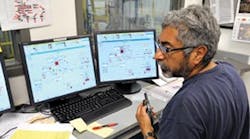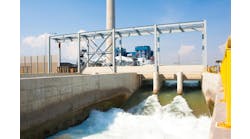Operator Station
Figure 1. Control system communicates via Profibus network with I/O modules and variable frequency drives.The configuration consists of a plug-flow reactor followed by a lower-temperature continuously stirred tank reactor.
Table 1 summarizes conditions in the two reactors. Conditions in the first stage favor the dominant fast first-order high-temperature acid-catalyzed hydrolysis of cellulosic and hemi-cellulose to soluble intermediates. Completely mixed conditions in the second-stage backmix reactor favor a first-order reaction sequence leading to levulinic acid. Calculations show the rate constant for glucose degradation at conditions in the second-stage reactor is at least an order-of-magnitude lower than that of cellulose degradation in the first stage. Additionally, reaction conditions in the first stage followed by vapor separation in the lower-pressure second stage favor high yields of furfural from the hemi-cellulose fraction of the feed.
Table 1. Reaction System
| Stage 1 |
Plug flow reactor, sulfuric acid
(1.5–3% concentration) catalyst,
210°–220°C, 25 barg, 12-sec.
residence time. |
| Stage 2 |
Continuously stirred tank reactor,
sulfuric acid (1.5–3% concentration)
catalyst, 190°–200°C, 14 barg, 20-min.
residence time. |
The overall process leading to commercial-grade levulinic acid consists of five steps carried out continuously: 1.
Feedstock preparation and mixing. Raw feedstock is ground to a particle size of around 0.5 cm and mixed with recycle dilute mineral acid. 2.
Hydrolysis. The main conversion reactions occur and ligneous char is separated from the reaction mixture. 3.
Product concentration. Water concentration is adjusted and formic acid and furfural, if present, are recovered. 4.
Recycle acid separation. Product is removed from the acid, which then is recycled.5.
Product recovery. Product either is converted to derivative products or further purified, if necessary.
Process AdvantagesThe technology boasts several important advantages over other levulinic acid and cellulose conversion ones: •
Compactness. The reaction is fast, so residence time in the reactor system is short and a small reactor volume can provide a high throughput. The process is sufficiently compact that an ocean-going "Panamax" barge can accommodate a self-contained 1,000-ton/day unit, according to a feasibility study. •
Low cost. The only reaction catalyst is low-cost dilute mineral acid that's recycled within the process, eliminating the need for disposal of waste salts. •
Feedstock flexibility. The process can handle a wide range of low-grade variable-composition cellulosic feedstocks or proposed dedicated energy crops such as willow, poplar, miscanthus grasses or switchgrass. •
Robustness. The conversion chemistry only depends on dilute-mineral-acid-catalyzed hydrolysis of carbohydrate polymers and is unaffected by contaminants typically found in waste feedstocks. •
Ease of operation. Hydrolysis occurs continuously. This affords the potential for significant process energy integration and reduces equipment size and labor requirements as well as maintenance and energy costs compared with comparable batch operations. •
Byproduct flexibility. Byproduct credits don't significantly affect process economics. It's easy to convert the furfural byproduct from hemi-cellulose to levulinic acid (via hydrogenation to furfural alcohol), thereby markedly increasing yield of the main product. Formic acid can be sold or converted to derivatives. •
Energy self-sufficiency. The char byproduct contains sufficient energy to satisfy all the steam and electric power needs of the process. At larger scale (above 300 t/d), the process produces significant excess power that can be exported to the grid.
The Importance of the Control SystemAt the heart of the demonstration plant is a Simatic PCS 7 process control system from Siemens Energy & Automation. The control system, installed and programmed by Siemens solution partner Optimation/Dumont Associates, includes redundant dual-screen operator stations communicating over industrial ethernet to the control processor (
Figure 1). The PCS 7 system uses a Profibus fieldbus network to communicate with input/output (I/O) modules and 20 Siemens Micromaster variable frequency drives (1 hp to 5 hp) controlling agitators and pumps. The focus of the project was to enhance productivity of the plant's startup and shutdown processes by capitalizing on past successes, says Joe Doherty, project manager at Optimation/Dumont Associates, which has worked with Biofine Renewables on previous related projects over the years and has a long-established relationship with Siemens. "We won the project when Biofine Renewables moved its plant from Glen Falls, N.Y., to Gorham," Doherty notes. "Fitzpatrick operated another plant that used the Siemens PCS 7 control system. It worked out so well for him that he wanted to use the same control system for this newly located plant." Operators monitor the demonstration plant from a central control room equipped with an engineering station and two redundant operator stations. Doherty says 50 different interlocks are programmed into the system. Operators can safely and efficiently override interlocks when required, allowing the process to continue under close supervision. "If something does happen, the PCS 7 system can quickly identify the cause," he notes. "In a continuous process, something like a low level alarm in one tank can cause the entire downstream process to shut down, so it is critical to quickly identify the issue. The PCS 7 system consistently maintains the steady state and makes adjustments automatically." The system automatically controls the sequential startup and shutdown process, beginning when wood chips or other feedstocks such as pulp-and-paper waste are fed from a large feed hopper into a grinder to be ground down to small particles. The sawdust-sized cellulose then is mixed with acid, heated and fed into reactors. Operators in the control room use 10-to-15 process graphics to visualize each step of the process. Sequential PCS 7 function charts are used to smooth startup and shutdown sequences, providing a visual guide for the steps and associated interlocks. "There is one master station and one slave station that operators can use to run multiple operations in parallel," Doherty says. "They see real-time data, including flow, pressure, level, temperature and acidity. Throughout the process, sensors automatically send signals from the plant to the PCS 7 controller via Profibus and to the graphics computers via industrial ethernet." The demonstration plant's reliability and control have substantially improved, probably by more than 50%, compared to operations in New York, notes Fitzpatrick. "The increased yield is primarily due to the tighter plantwide control provided by the PCS 7 control system and its integration with the electrical and lab systems," he says. "The control system responds to our needs and requirements. It is also certainly flexible enough to deal with the different types of feedstocks."
Data and Diagnostic BenefitsEventually making their way to an Excel spreadsheet, the data generated by the process are Biofine Renewables' bread and butter. Fitzpatrick must prove to investors and potential clients that the intermediates will help make second-generation biofuels and biochemicals available to the market. Optimation/Dumont Associates worked extensively to link process data with a custom database and laboratory sample data, allowing operators to complete their material balance calculations throughout the day and determine process yields, says Doherty. "We have integrated the PCS 7 system with our lab information system," Fitzpatrick notes. "We can get a complete download of process data from PCS 7 and coordinate it with independently generated laboratory analytical data." That coordination of data is important to Biofine Renewables' investors and potential clients because it identifies areas requiring further investigation and helps tailor experimentation accordingly. "Sure, you can look at one sheet of data and compare it with another — but to have it coordinated, complete and together, is a nice feature that enables us to more effectively use our resources and minimizes duplication," Fitzpatrick explains. "The PCS 7 system provides data that are systematic, businesslike and understandable. We do not have to cross-reference complex data sets with operations. That is done automatically." Another control system benefit is the ability to provide Optimation/Dumont Associates with remote access via the Internet to the plant's engineering station. By troubleshooting over the phone and Internet, Doherty estimates he spends 20 minutes diagnosing and solving problems, eliminating the two-hour trip to the demonstration plant. "We can go online and look at the process, identify the issue and make or suggest changes," Doherty says. "We can respond from home or work any time of the day. In the beginning, they had some mechanical process issues with their equipment. It was not obvious if it was a software issue, a process issue or if something broke. We were able to point them in the right direction to confirm that it was a hardware issue."
The Next StepBiofine Renewables is considering two potential large-scale projects in the near future, says Fitzpatrick. Now in the planning stages, these would produce heating oil as well as biodiesel fuel and building block chemicals such as levulinic acid. "We intend to standardize on the Siemens system as we scale up," he adds. "The graphics are intuitive and the trending and alarm functions are very good. The customer service support from Optimation/Dumont has been impressive as well. It is always better in a scale up to have consistency with proven partners and technology."
Rich Chmielewski is marketing manager for Siemens Industry, Inc., Spring House, Pa. E-mail him at[email protected].

